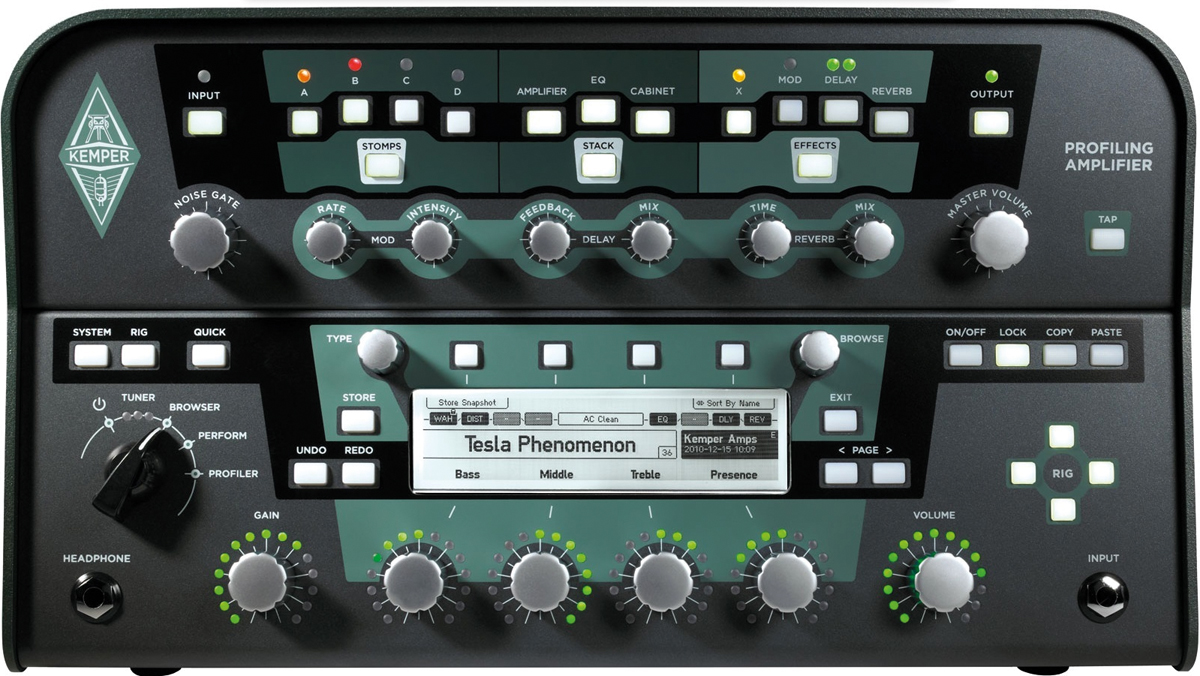Related Tags
Kemper Profiler Head Review
Pino Palladino, Tony Levin and a bunch of other big names are using the Kemper Profiler, now expanded for bass.

Details
Specs: Single-channel 600W digital profiling/modelling amplifier for bass. Made in Germany
RRP: £1542
Contact: +49 2361 937 6824 www.kemperamps.com
In 2011 Christoph Kemper, developer of Access Virus synthesisers, launched the Profiler, a system for profiling or modelling guitar amps which, rather than employing analysing circuitry, uses a note or sound the amp creates as a basis for the ‘profile’.
These are then stored and can then be combined in innumerable ways together with stored profiled effects, a selection of modelled cabinets and other amp profiles, and naturally they can also be EQ’d.
Of course, all the results can be tucked away for future reference and you can get online updates via USB stick from Kemper’s website, where a library of shared profiles is also accessible. Not only that, using a simple mic’ing process and appropriate connections (all clearly explained in the frankly daunting 69-page manual), you can profile sounds from favourite amps, creating a massive amp/cab/FX library for gigs or studio.
Up to now bass players weren’t getting the benefit of Kemper’s system but that’s all changed with a ‘re-veiling’ of the Profiler – with added bass power.
It’s still housed in a green metal chassis with grey front and back panels approximately 394mm wide, 215mm high and 176mm deep, and its 6kg/13lb payload is unlikely to cause sleepless nights.
The Profiler Head has 600W under its hood (the rack version is non-powered) and there’s a dizzying selection of controls, ranging from some with commonly identifiable functions – Gain, Noisegate, Mix– to the bottom mainly unlabelled row controlling EQ and a myriad of white flashing buttons. The rear panel is equally impressive with FX loop, speaker, MIDI, USB and DI Out connectivity, amongst others. Sounds
Sounds
The bass patches are added to the alphabetic directory of profiles, although we’ve have preferred them in a designated section. You’ll do lot of menu trawling early on, although the library order can be easily manipulated. Assessing the sounds is almost pointless as you can add to the library from both your own raw material and website, but checking out shaping possibilities is well worth it.
Browsing through for bass sounds is not the most fun thing in the world to do but we settled on one called Black Bass Clean, ditching the reverb and chorus. The LED display panel is well laid out, with FX/shaping chain along the top, author’s name on the right and EQ along the bottom, below name of the chosen sound.
Black Bass is a thick tone with warm, valve fatness, a slightly soupy, dark-hued midrange and clean, even highs. Using the EQ parameters – Bass, Middle, Treble and Presence – with five clicks of cut or boost indicated onscreen, you can thin it out, uncovering a wonderfully even full-range sound, or boost for a room-shaking woolly overload.
Cutting Middle scoops the proceedings but boosting tightens everything up, adding contemporary crispness and attack. Treble and Presence spring clean the highs which sing without inducing fret noise, enlivening across the whole fretboard. With this patch, the EQ works so instinctively that cuts and boosts do exactly what you expect.
Verdict
To say we’ve scratched the surface here is the understatement of the century. This is a really important piece of kit for guitarists and bassists, with zillions of uses and endless potential. If you’re a sonically inquisitive guitarist or bassist, or write and record for a living, this may be one of the most important purchases you’ll ever make, especially if you learn to make your own profiles effectively. It’s complex, but if you try one, you will certainly have a massive re-think.
